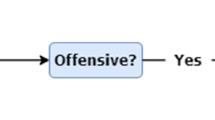Abstract
Social media has revolutionized the manner in which our society is interconnected. While this extensive connectivity offers numerous benefits, it is also accompanied by significant drawbacks, particularly in terms of the proliferation of fake news and the vast dissemination of hate speech. Identifying offensive comments is a critical task for ensuring the safety of users, which is why industry and academia have been working on developing solutions to this problem. Prior research on hate speech detection has predominantly focused on the English language, with few studies devoted to other languages such as Portuguese. This paper introduces the Offensive Language Identification Dataset for Brazilian Portuguese (OLID-BR), a high-quality NLP dataset for offensive language detection, which we make publicly available. The dataset contains 6,354 (extendable to 13,538) comments labeled using a fine-grained three-layer annotation schema compatible with datasets in other languages, which allows the training of multilingual/cross-lingual models. The five NLP tasks available in OLID-BR allow the detection of offensive comments, the classification of the types of offenses such as racism, LGBTQphobia, sexism, xenophobia, and so on, the identification of the type and the target of offensive comments, and the extraction of toxic spans of offensive comments. All those tasks can enhance the capabilities of content moderation systems by providing deep contextual analysis or highlighting the spans that make a text toxic. We further experiment with and evaluate the dataset using state-of-the-art BERT-based and NER models, which demonstrates the usefulness of OLID-BR for the development of toxicity detection systems for Portuguese texts.












Similar content being viewed by others
Availability of data and materials
The dataset created in this work is available on Kaggle (https://www.kaggle.com/dougtrajano/olidbr) and HuggingFace (https://huggingface.co/datasets/dougtrajano/olid-br).
Code availability
The source code and experiments for this paper are available on the GitHub platform at https://dougtrajano.github.io/olid-br/ and https://dougtrajano.github.io/ToChiquinho/.
Notes
References
Alonso, P., Saini, R., & Kovács, G. (2020). Hate speech detection using transformer ensembles on the hasoc dataset. In International Conference on Speech and Computer (pp. 13–21). Springer
Basile, V., Bosco, C., & Fersini, E., et al. (2019). Semeval-2019 task 5: Multilingual detection of hate speech against immigrants and women in twitter. In Proceedings of the 13th international workshop on semantic evaluation (pp. 54–63).
Çöltekin, Ç. (2020). A corpus of turkish offensive language on social media. In Proceedings of the 12th language resources and evaluation conference (pp. 6174–6184).
de Pelle, R. P., & Moreira, V. P. (2017). Offensive comments in the brazilian web: a dataset and baseline results. In Anais do VI Brazilian Workshop on Social Network Analysis and Mining. SBC.
Eugenio, B. D., & Glass, M. (2004). The kappa statistic: A second look. Computational Linguistics, 30(1), 95–101.
Feinstein, A. R., & Cicchetti, D. V. (1990). High agreement but low kappa: I. the problems of two paradoxes. Journal of Clinical Epidemiology, 43(6), 543–549.
Fortuna, P., & Nunes, S. (2018). A survey on automatic detection of hate speech in text. ACM Computing Surveys (CSUR), 51(4), 1–30.
Fortuna, P., da Silva, J. R., & Wanner, L., et al. (2019). A hierarchically-labeled portuguese hate speech dataset. In Proceedings of the Third Workshop on Abusive Language Online (pp. 94–104).
Gwet, K. L. (2014). Handbook of inter-rater reliability: The definitive guide to measuring the extent of agreement among raters. Gaithersburg, MD, USA: Advanced Analytics, LLC.
Han, J., Kamber, M., & Pei, J. (2011). Data mining: Concepts and techniques (3rd ed.). San Francisco, CA, USA: Morgan Kaufmann Publishers Inc.
Leite, J. A., Silva, D., & Bontcheva, K., et al. (2020). Toxic language detection in social media for Brazilian Portuguese: New dataset and multilingual analysis. In Proceedings of the 1st Conference of the Asia-Pacific Chapter of the Association for Computational Linguistics and the 10th International Joint Conference on Natural Language Processing. Association for Computational Linguistics, Suzhou, China, pp. 914–924, https://aclanthology.org/2020.aacl-main.91
Levy, L., Karst, K., & Winkler, A. (2000). Encyclopedia of the American Constitution. No. v. 6 in Encyclopedia of the American Constitution, Macmillan Reference USA, USA.
Nascimento, G., Carvalho, F., & Cunha, A. M. d., et al. (2019). Hate speech detection using brazilian imageboards. In Proceedings of the 25th Brazillian Symposium on Multimedia and the Web (pp. 325–328).
Pavlopoulos, J., Sorensen, J., & Laugier, L., et al. (2021). SemEval-2021 task 5: Toxic spans detection. In Proceedings of the 15th International Workshop on Semantic Evaluation (SemEval-2021). Association for Computational Linguistics, Online, pp. 59–69, https://doi.org/10.18653/v1/2021.semeval-1.6, https://aclanthology.org/2021.semeval-1.6
Pitenis, Z., Zampieri, M., & Ranasinghe, T. (2020). Offensive language identification in Greek. In Proceedings of the Twelfth Language Resources and Evaluation Conference. European Language Resources Association (pp. 5113–5119). Marseille, France. https://aclanthology.org/2020.lrec-1.629
Poletto, F., Basile, V., Sanguinetti, M., et al. (2021). Resources and benchmark corpora for hate speech detection: a systematic review. Language Resources and Evaluation, 55(2), 477–523.
Raghunathan, B. (2013). The complete book of data anonymization: From planning to implementation. Auerbach Publications.
Rosenthal, S., Atanasova, P., Karadzhov, G., et al. (2021). Solid: A large-scale semi-supervised dataset for offensive language identification. Findings of the Association for Computational Linguistics: ACL-IJCNLP, 2021, 915–928.
Shelar, H., Kaur, G., Heda, N., & Mai. (2020). Named entity recognition approaches and their comparison for custom ner model. Science & Technology Libraries, 39, 324–337. https://doi.org/10.1080/0194262X.2020.1759479
Siddiqui, S., Singh, T., et al. (2016). Social media its impact with positive and negative aspects. International Journal of Computer Applications Technology and Research, 5(2), 71–75.
Sigurbergsson, G. I., & Derczynski, L. (2020). Offensive language and hate speech detection for danish. In Proceedings of the 12th Language Resources and Evaluation Conference (pp. 3498–3508).
Souza, F., Nogueira, R., & Lotufo, R. (2020). Bertimbau: pretrained bert models for brazilian portuguese. In Brazilian Conference on Intelligent Systems (pp. 403–417). Springer.
Vaswani, A., Shazeer, N., & Parmar, N., et al. (2017). Attention is all you need. In Advances in neural information processing systems (pp. 5998–6008). Curran Associates, Inc.
Zampieri, M., Malmasi, S., & Nakov, P., et al. (2019a). Predicting the type and target of offensive posts in social media. In Proceedings of the 2019 Conference of the North American Chapter of the Association for Computational Linguistics: Human Language Technologies Volume 1 (Long and Short Papers). Association for Computational Linguistics, Minneapolis, Minnesota, pp. 1415–1420, https://doi.org/10.18653/v1/N19-1144, https://aclanthology.org/N19-1144
Zampieri, M., Malmasi, S., & Nakov, P., et al. (2019b). Semeval-2019 task 6: Identifying and categorizing offensive language in social media (offenseval). In Proceedings of the 13th International Workshop on Semantic Evaluation (pp. 75–86).
Zampieri, M., Nakov, P., & Rosenthal, S., et al. (2020). Semeval-2020 task 12: Multilingual offensive language identification in social media (offenseval 2020). In Proceedings of the Fourteenth Workshop on Semantic Evaluation (pp. 1425–1447).
Acknowledgements
We gratefully acknowledge the financial support of Uol EdTech, Brazilian National Council for Scientific and Technological Development (CNPq), and Portuguese Foundation for Science and Technology (FCT) under the projects CEECIND/01997/2017, UIDB/00057/2020.
Author information
Authors and Affiliations
Contributions
All authors contributed to the conception and design of the work. DT contributed to the data collection, data processing, annotation process, data analysis, and performed the experiments. All authors reviewed the work, contributed to the writing of the manuscript, and approved the final manuscript.
Corresponding author
Ethics declarations
Conflict of interest
The authors declared no potential conflicts of interest concerning this article’s research, authorship, and publication.
Ethical approval
All procedures performed in studies involving human participants were in accordance with the ethical standards of the Research Ethics Committee of the Pontifical Catholic University of Rio Grande do Sul (PUCRS) and with the 1964 Helsinki declaration and its later amendments or comparable ethical standards.
Additional information
Publisher's Note
Springer Nature remains neutral with regard to jurisdictional claims in published maps and institutional affiliations.
Rights and permissions
Springer Nature or its licensor (e.g. a society or other partner) holds exclusive rights to this article under a publishing agreement with the author(s) or other rightsholder(s); author self-archiving of the accepted manuscript version of this article is solely governed by the terms of such publishing agreement and applicable law.
About this article
Cite this article
Trajano, D., Bordini, R.H. & Vieira, R. OLID-BR: offensive language identification dataset for Brazilian Portuguese. Lang Resources & Evaluation (2023). https://doi.org/10.1007/s10579-023-09657-0
Accepted:
Published:
DOI: https://doi.org/10.1007/s10579-023-09657-0




